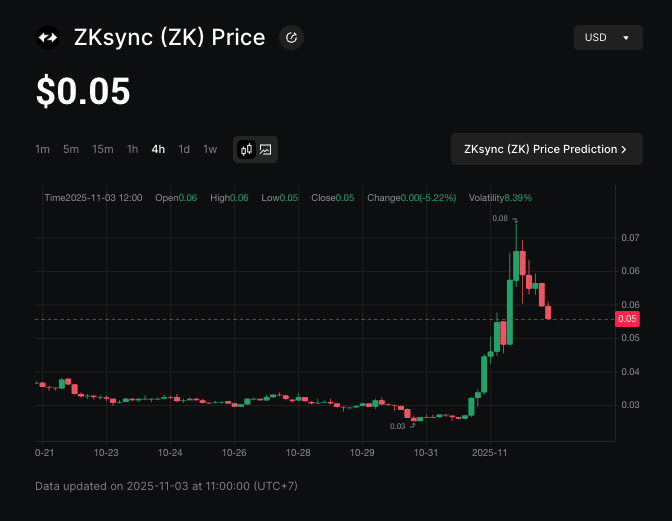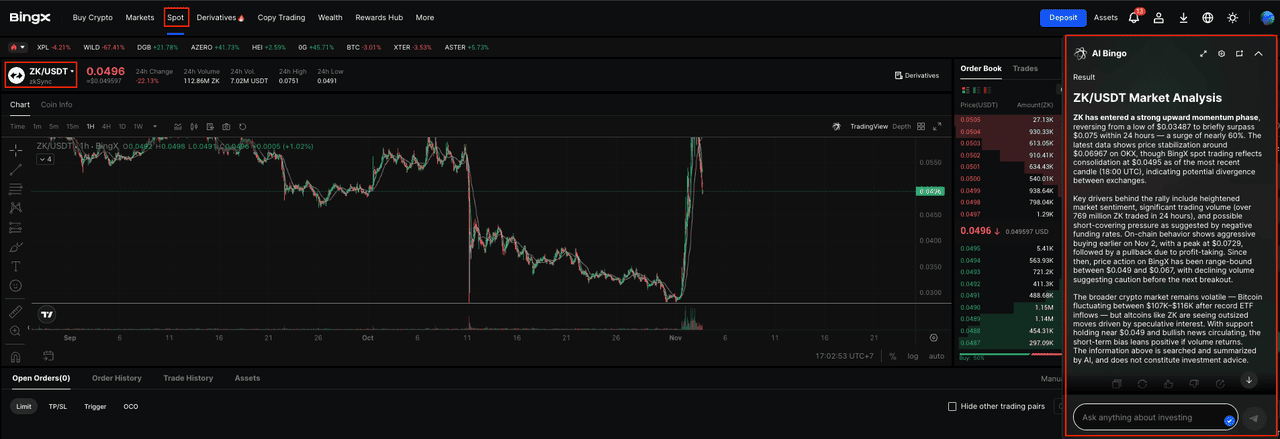ZKsync (ZK) is a proof-secured network of chains that uses zero-knowledge rollups to batch transactions off-chain and finalize them on Ethereum. With over 700 million transactions processed, it pairs EVM compatibility with privacy and compliance features for real-world use cases, while ZK powers governance through delegation.
On Nov 1, 2025, ZK jumped after Ethereum co-founder Vitalik Buterin publicly praised ZKsync in a post, helping spark a sharp rally; over the last 7 days the token is up more than 60%.
In this guide, you’ll learn what ZKsync (ZK) is, how it works, its core utilities, and how to trade it on BingX.
ZKsync (ZK) price chart 4h | Source:
BingXWhat Is ZKsync (ZK) and How Does It Work?
ZKsync is a network of public and private chains secured by cryptographic proofs, not validators. It uses
zero-knowledge rollups that bundle many transactions off-chain, then prove their correctness on
Ethereum. A zero-knowledge proof shows something is true without revealing the underlying data.
Here’s the flow: transactions are batched, a proof is generated that every step is valid, and that proof is submitted to Ethereum for verification and finality. The result is lower fees, higher throughput, ~1-second hops between connected chains, and finality on Ethereum within minutes.
Built on the
EVM, ZKsync lets teams launch customized, high-performance systems that they can self-host or run as a managed service, with full observability. The network acts like a proof-secured fabric linking multiple chains so apps can move assets and messages atomically. The reported metrics on the ZKsync website include 18 chains in the network, over $4 billion in value secured and over 700 million transactions processed.
For institutions, ZKsync adds selective disclosure, compliance controls, and private execution with public price integrity, powered by low-latency proofs and a high-performance sequencer that publishes verifiable outcomes to the Ethereum network.
Why Did ZKsync (ZK) Surge by over 60%?
Buterin’s endorsement lit the spark
On 1 November, Vitalik Buterin publicly endorsed a ZKsync post, describing the project's work as "underrated and valuable" and amplifying a message about Ethereum's "incorruptibility". This endorsement from the co-founder of Ethereum attracted attention, led to faster news coverage and attracted liquidity to ZK, causing a sharp increase in price from around $0.03 to $0.5.
Atlas upgrade strengthened the fundamentals
ZKsync rolled out Atlas, adding a high-performance sequencer targeting up to 30,000 TPS, full Ethereum compatibility, and Airbender for quick confirmations and faster cross-chain settlement. Framing Atlas for enterprise and institutional use cases (payments,
tokenized assets, cross-border settlement) gave traders a clearer utility narrative to buy into, reinforcing the price breakout.
ZK Tokenomics and Allocation
An airdrop distributed 17.5% of total supply to eligible
wallets across users and contributors. Usage-based allocations were guided by a value-scaling formula that computed each address’s time-weighted average balance over a 366-day snapshot period, with assets in
DeFi counted at twice nominal value before averaging.
Additional multipliers applied for activities signaling genuine usage, such as holding specified native
NFTs or retaining portions of prior major airdrops for more than 90 days. Contributor distributions included explicit tranches: allocations to native projects and their treasuries building on ZKsync, to builders such as developers and researchers, and to experimental on-chain communities.
What Are the Core Use Cases of ZKsync and ZK?
ZKsync
• Proof-based trust: Execute privately and publish proofs of correctness to preserve public price integrity.
• Cross-border settlement: Cryptographic settlement with ~1-second network hops and minutes-to-Ethereum finality, without trusted third parties.
• Tokenized real-world assets: Issue and settle treasuries, fund shares, and private credit with user-level privacy and selective disclosure for policy compliance.
• Identity and compliance: Enforce
KYC/AML, integrate your own authentication, streamline onboarding with passkeys and gasless participation.
• Programmable capital markets: Run private order flow, orchestrate collateral atomically across systems, and capture
MEV under your rules.
• Launch your own chain: EVM-based, customizable systems via ZK Stack, self-hosted or managed, with full observability and connectivity to global liquidity.
ZK token
• Governance: Activate voting power by delegating to a ZKsync address (yours or another). Ownership does not change, delegation is editable, and one wallet’s voting power cannot be split across multiple delegates.
• Community incentives: Airdrop and ecosystem allocations rewarded users, builders, native projects, and selected on-chain communities, with multipliers for authentic participation.
How to Trade ZKsync (ZK) on BingX
Whether you are building a long-term ZK position, trading short-term volatility, or reacting to major news events, BingX provides flexible ways to trade the token. With
BingX AI integrated directly into the trading interface, you can access real-time insights to support smarter trading decisions across both spot and futures markets.
How to Trade ZK on the Spot Market
ZK/USDT trading pair on the spot market powered by Bingx AI
1. Find the market: Open BingX and search
ZK/USDT in
Spot.
2. Plan the trade: On the chart, click the AI icon to view support and resistance, breakout zones, and suggested entry areas. Decide your entry, stop loss, and take profit.
3. Place and manage the order: Choose Limit or
Market, set size, and confirm. Add your stop loss and take profit immediately. If needed, deposit ZK or USDT and verify the correct network before trading.
Always conduct your own research (
DYOR). Diversify your portfolio and never invest more than you can afford to lose.
How to Trade ZK Perpetual Futures
ZK/USDT perpetual contract on BingX futures powered by AI BingX
Futures, especially perpetual futures, let you trade ZK price movements with leverage; you don’t necessarily need to hold the underlying ZK. You can go long (betting price will rise) or short (betting price will fall). BingX offers a
ZK-USDT perpetual contract.
1. Switch to the futures/perpetual trading section in BingX: Navigate to
Futures and locate ZK-USDT perpetual contract.
2. Review contract specifications: Things to check include:
• Leverage limits, e.g. 5×, 10×, etc.
• Maintenance margin and initial margin rates
• Funding rate (periodic payments between longs and shorts)
• Mark price, index price, and settlement rules
3. Choose direction (Long or Short) and leverage: Based on your market view, open a long or short position. Leverage amplifies both gains and losses, so use with caution.
4. Set entry, exit & risk controls
• Use take-profit orders
• Monitor your margin level
• Be mindful of liquidation risk (if losses push margin below maintenance).
5. Monitor funding and rollovers: As a perpetual contract, there will be a funding rate mechanism (to keep contract price close to the spot). Depending on whether you're long or short, you may either pay or receive funding periodically.
6. Close the position: When your target is hit (or your stop), close the position, and your P&L (profit/loss) will be settled in USDT.
Final Notes
ZKsync is a proof-secured network of public and private chains that uses zero-knowledge rollups to batch transactions off-chain and finalize them on Ethereum. It is EVM compatible, built for privacy and compliance, and ZK powers governance via delegation.
Before depositing or trading, verify the ticker ZK, the network, and the contract address. Watch for phishing and fake support and never share seed phrases or private keys. In volatile markets, prefer limit orders and review fees, slippage, funding for perpetuals, margin requirements, and the gap between mark and index price.
Size positions conservatively, set stop loss and take profit in advance, and understand liquidation risk with leverage. This is educational content. Do your own research and only risk capital you can afford to lose.
Related Reading





